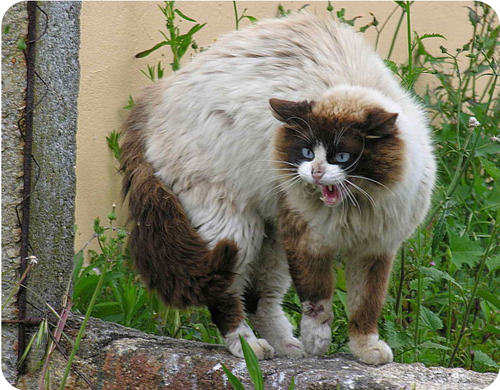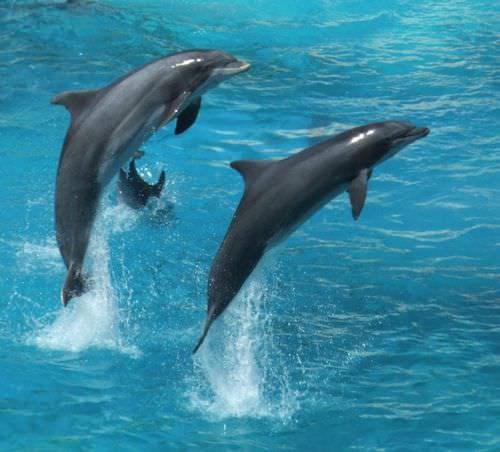12.24 哺乳动物概览
章节大纲
-
One of these is not a mammal. Which one?
::其中一个不是哺乳动物,哪一个?Mammals are a class of endothermic vertebrates . They have four limbs and produce amniotic eggs . Examples of mammals include bats, whales, mice, and humans. Clearly, mammals are a very diverse group. Nonetheless, they share many traits that set them apart from other vertebrates.
::哺乳动物是顶端热性脊椎动物的一类,它们有四肢并产出羊蛋,哺乳动物的例子包括蝙蝠、鲸、老鼠和人类。很明显,哺乳动物是一个非常多样化的群体。尽管如此,它们与其他脊椎动物有许多不同的特征。Characteristics of Mammals
::哺乳动物的特点Two characteristics are used to define the mammal class. They are mammary glands and body hair (or fur).
::哺乳类有两种特性,它们是哺乳腺和身体毛(或毛皮)。-
Female mammals have
mammary glands
. The glands produce milk after the birth of offspring. Milk is a nutritious fluid. It contains disease-fighting molecules as well as all the
nutrients
a baby mammal needs. Producing milk for offspring is called
lactation
.
::雌性哺乳动物有哺乳腺,雄性腺在后代出生后产奶,牛奶是一种营养液,含有抗疾病分子和婴儿哺乳需要的所有营养物质,为后代生产奶制品称为哺乳。 -
Mammals have hair or fur. It insulates the body to help conserve body heat. It can also be used for sensing and communicating. For example, cats use their whiskers to sense their surroundings. They also raise their fur to look larger and more threatening (see
Figure
).
::哺乳动物有毛毛或毛皮,它使身体绝缘,以帮助保持体温,还可以用于感知和交流。例如,猫用胡须来感知周围环境。它们还提高毛皮,以看起来更大、更有威胁(见图 )。
Cat Communicating a Warning. By raising its fur, this cat is “saying” that it’s big and dangerous. This might discourage a predator from attacking.
::猫会发出警告。 通过提高毛皮,这只猫“说 ” , “ 说 ” , “ 这是大而危险的。 这可能会阻止捕食者发动攻击。 ”Most mammals share several other traits. The traits in the following list are typical of, but not necessarily unique to, mammals.
::大多数哺乳动物具有其他几种特性,下列清单中的特性是哺乳动物的典型特征,但不一定是哺乳动物的独有特征。-
The skin of many mammals is covered with
sweat glands
. The glands produce sweat, the salty fluid that helps cool the body.
::许多哺乳动物的皮肤上都沾满了汗腺,这些腺产生汗,盐水,帮助身体降温。 -
Mammalian
lungs
have millions of tiny
air sacs
called
alveoli
. They provide a very large surface area for gas exchange.
::哺乳动物肺里有数百万微小的空气囊,叫做Alveoli。它们为气体交换提供了非常大面积的地表面积。 -
The heart of a mammal consists of four chambers. This makes it more efficient and powerful for delivering oxygenated
to
tissues
.
::哺乳动物的心脏由四间房组成。这使得它更有效率,更能把氧气输送到组织中。 -
The
brain
of a mammal is relatively large and has a covering called the
neocortex
. This structure plays an important role in many complex brain functions.
::哺乳动物的大脑相对较大,并有一个称为新皮层的封面。这个结构在许多复杂的大脑功能中起着重要作用。 -
The mammalian middle ear has three tiny
that carry sound vibrations from the outer to inner ear. The bones give mammals exceptionally good
hearing
. In other vertebrates, the three bones are part of the jaw and not involved in hearing.
::哺乳动物中耳有三个很小的小耳,从外耳到内耳都有声音振动。 骨头给哺乳动物的听力特别好。 在其他脊椎动物中,三根骨头是下巴的一部分,与听力无关。 -
Mammals have four different types of teeth. The teeth of other vertebrates, in contrast, are all alike.
::哺乳动物有四种不同的牙齿,而其他脊椎动物的牙齿则相似。
Dolphins are mammals that have adapted to swimming and reproducing in water.
::海豚是适应游泳和在水中繁殖的哺乳动物。Summary
::摘要-
Mammals are a class of endothermic vertebrates.
::哺乳动物是终极热热性脊椎动物的一类。 -
Mammals have four limbs and produce amniotic eggs.
::哺乳动物有四肢,生产羊蛋。 -
The mammal class is defined by the presence of mammary glands and hair (or fur).
::哺乳类的定义是哺乳腺和毛发(或毛皮)的存在。 -
Other traits of mammals include sweat glands in their skin, alveoli in their lungs, a four-chambered heart, and a brain covering called the neocortex.
::哺乳动物的其他特征包括皮肤中的汗腺、肺中的叶绿素、四位细胞的心脏以及一个覆盖新皮层的大脑。
Review
::回顾-
List five traits that are shared by all mammals, including the two traits that are used to define the mammal class.
::列出所有哺乳动物共有的五种特性,包括用于界定哺乳动物类别的两种特性。
-
Female mammals have
mammary glands
. The glands produce milk after the birth of offspring. Milk is a nutritious fluid. It contains disease-fighting molecules as well as all the
nutrients
a baby mammal needs. Producing milk for offspring is called
lactation
.


